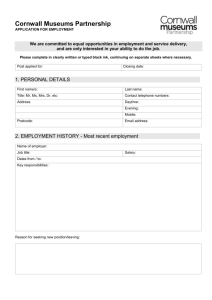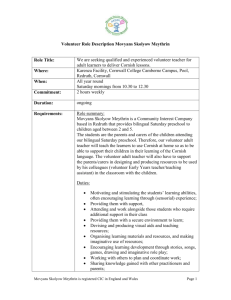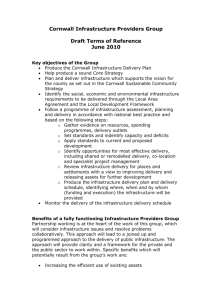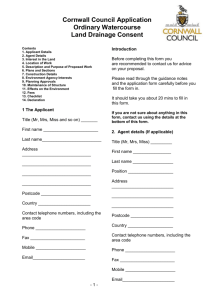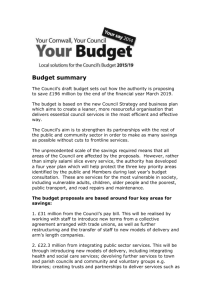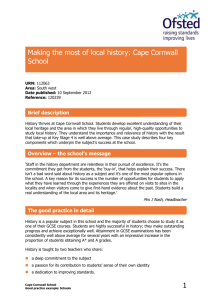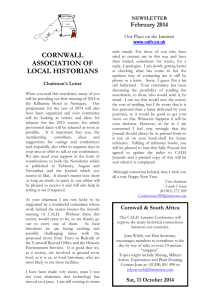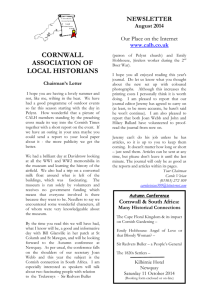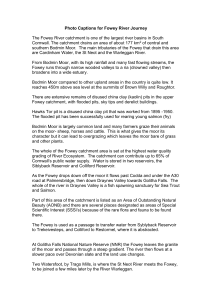w - Faulkner Family History
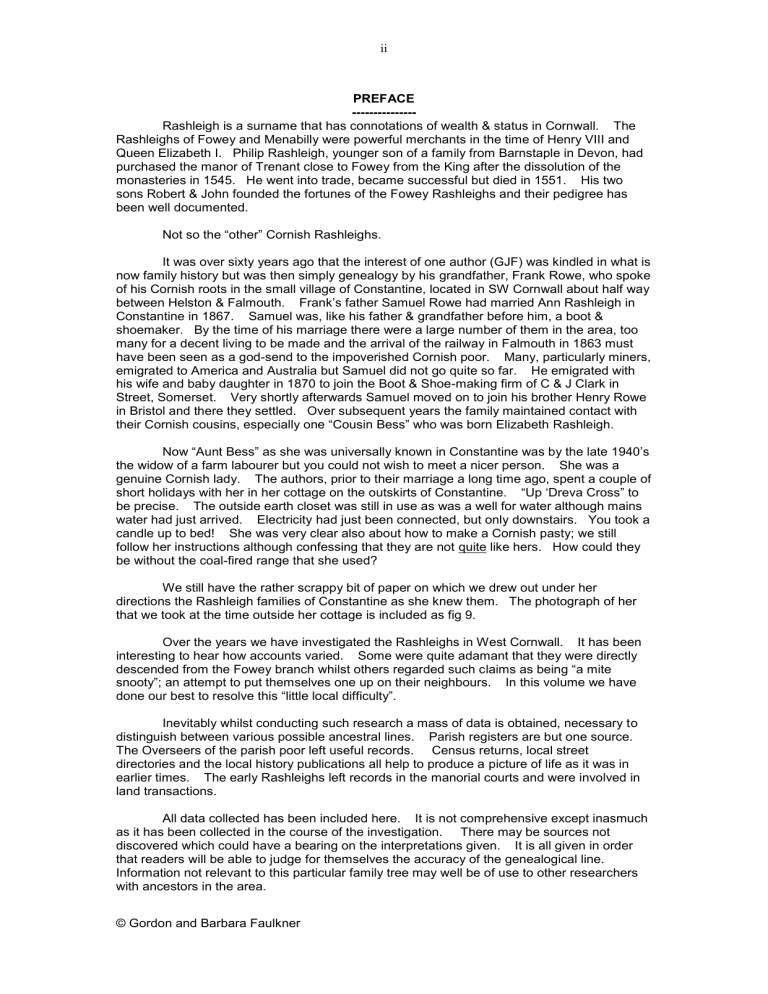
ii
PREFACE
---------------
Rashleigh is a surname that has connotations of wealth & status in Cornwall. The
Rashleighs of Fowey and Menabilly were powerful merchants in the time of Henry VIII and
Queen Elizabeth I. Philip Rashleigh, younger son of a family from Barnstaple in Devon, had purchased the manor of Trenant close to Fowey from the King after the dissolution of the monasteries in 1545. He went into trade, became successful but died in 1551. His two sons Robert & John founded the fortunes of the Fowey Rashleighs and their pedigree has been well documented.
Not so the “other” Cornish Rashleighs.
It was over sixty years ago that the interest of one author (GJF) was kindled in what is now family history but was then simply genealogy by his grandfather, Frank Rowe, who spoke of his Cornish roots in the small village of Constantine, located in SW Cornwall about half way between Helston & Falmouth. Frank’s father Samuel Rowe had married Ann Rashleigh in
Constantine in 1867. Samuel was, like his father & grandfather before him, a boot & shoemaker. By the time of his marriage there were a large number of them in the area, too many for a decent living to be made and the arrival of the railway in Falmouth in 1863 must have been seen as a god-send to the impoverished Cornish poor. Many, particularly miners, emigrated to America and Australia but Samuel did not go quite so far. He emigrated with his wife and baby daughter in 1870 to join the Boot & Shoe-making firm of C & J Clark in
Street, Somerset. Very shortly afterwards Samuel moved on to join his brother Henry Rowe in Bristol and there they settled. Over subsequent years the family maintained contact with their Cornish cousins, especially one “Cousin Bess” who was born Elizabeth Rashleigh.
Now “Aunt Bess” as she was universally known in Constantine was by the late 1940’s the widow of a farm labourer but you could not wish to meet a nicer person. She was a genuine Cornish lady. The authors, prior to their marriage a long time ago, spent a couple of short holidays with her in her cottage on the outskirts of Constantine. “Up ‘Dreva Cross” to be precise. The outside earth closet was still in use as was a well for water although mains water had just arrived. Electricity had just been connected, but only downstairs. You took a candle up to bed! She was very clear also about how to make a Cornish pasty; we still follow her instructions although confessing that they are not quite like hers. How could they be without the coal-fired range that she used?
We still have the rather scrappy bit of paper on which we drew out under her directions the Rashleigh families of Constantine as she knew them. The photograph of her that we took at the time outside her cottage is included as fig 9.
Over the years we have investigated the Rashleighs in West Cornwall. It has been interesting to hear how accounts varied. Some were quite adamant that they were directly descended from the Fowey branch whilst others regarded such c laims as being “a mite snooty”; an attempt to put themselves one up on their neighbours. In this volume we have done our best to resolve this “little local difficulty”.
Inevitably whilst conducting such research a mass of data is obtained, necessary to distinguish between various possible ancestral lines. Parish registers are but one source.
The Overseers of the parish poor left useful records. Census returns, local street directories and the local history publications all help to produce a picture of life as it was in earlier times. The early Rashleighs left records in the manorial courts and were involved in land transactions.
All data collected has been included here. It is not comprehensive except inasmuch as it has been collected in the course of the investigation. There may be sources not discovered which could have a bearing on the interpretations given. It is all given in order that readers will be able to judge for themselves the accuracy of the genealogical line.
Information not relevant to this particular family tree may well be of use to other researchers with ancestors in the area.
© Gordon and Barbara Faulkner
iii
The surname Rashleigh has over the years been spelt in a variety of ways; Rashely;
Rashely; Rasly; Rasley are just some. In this book it has been rendered as “Rashleigh” however it has been found although exceptions have very occasionally been made in the transcriptions of original documents. Then the literal spelling is used.
For other surnames and most Christian names a standard modern spelling has been adopted although the original is often variable. Similarly the spelling of place names, in particular small remote farming tenements, has varied considerably. In almost all cases these names have been modernised.
As a means of identification in the text a date (less 1000) has sometimes been given in brackets after a Christian name. This is the year of birth/baptism of the person named and is used to distinguish, where appropriate, between persons with the same Christian name. In the event that the date of birth is merely an informed guess the number has been italicised.
We have included in Chapter 5 summaries of the Rashleigh wills, administrations and
Inquisitions Post Mortem that we have found. They have been listed and numbered with their source reference at the start of the chapter. Each has been given a number, prefixed
“W” which is used throughout this book as a reference. Thus “W7” refers to the will of
Petherick Rashleigh of Cury. Its probate was granted in 1664 and it bears the Cornwall
Record Office reference of AP/RB.
Similarly included in Chapter 6 is all the other Rashleigh information we have discovered. It has been collated under appropriate general headings that are listed at the star t of the chapter, again with a reference number, prefixed “R”, used throughout the book.
As an example references to Rashleigh in the various Lists & Surveys published by Stoate are included as “R7”.
This is the second volume we have written about our Cornish ancestors. They were mostly not wealthy but they did have the wisdom to live in a delightful part of the country although they may not have seen it quite that way. Fortunately there are several more ancestral lines that we have not yet fully explored so we still have plenty of excuses to re-visit what has become a home from home. It still conjures up memories of “Cousin Bess”
Gordon & Barbara Faulkner
Bristol 2001
© Gordon and Barbara Faulkner
iv
ACKNOWLEDGEMENTS
----------------------------------
We are grateful for the help received from many sources. In particular mention should be made of the following, a list which is probably not comprehensive:-
Cornwall County Record Office, Truro
RIC Courtney Library, Royal Institution of Cornwall, Truro
Cornwall Family History Society
Devon County Record Office, Exeter
The West County Studies Library, Exeter
North Devon Record Office, Barnstaple
Bristol Record Office, Bristol
Bristol Reference Library
Bristol & Avon Family History Society
Public Record Office, Kew
Family Records Centre, Myddleton Street, London
The Society of Genealogists, London
Church of Jesus Christ of LDS for their IGI
Invariably the staff at all these locations were most obliging, directing our tentative footsteps to many sources which would have otherwise have remained undiscovered.
Particular mention must be made of the translations & transcriptions of early documents by Mrs Margaret McGregor and the staff at Bristol Record Office.
Whilst every effort has been made to ensure the accuracy of the information included here, any errors are solely the responsibility of the authors.
BIBLIOGRAPHY
-----------------------
“Churches & Antiquities of Cury & Gunwalloe” by A H Cummins (pub 1875)
“The Story of Fowey” by John Keast 1950
“Tudor Cornwall” by A.L.Rowse 1949
“Trefusis Territory” by U M Redwood 1987
“Constantine in Cornwall” by Charles Henderson 1937
“Essays in Cornish History” by Charles Henderson (Ed Rowse & Henderson) 1963
“Around Helston in the OLd Days” by A S Oates 1951
“History of Glasney College” by James Whetter 1988
“St Constantine in Cornwall” by I & D Fraser-Harris 1975
“St. Budock” vols I & II, by the Budock Parish History Group 1993
“Cornish Weather & Cornish People in the 17C” by James Whetter
“Story of Parish Church of Manaccan” by Rev H H Dixon 1996 edn.
“St Anthony in Meneage” by Rev H H Dixon 1978
“Mawnan Parish Church” undated.
Various Indexed Transcripts by T.L.Stoate
© Gordon and Barbara Faulkner
v
ABBREVIATIONS
----------------------
CRO Cornwall County Record Office, Truro
RIC Courtenay Library, Royal Institute of Cornwall, Truro
CFHS Cornwall Family History Society
DRO Devon County Record Office, Exeter
WCSL The West County Studies Library, Exeter
NDRO North Devon Record Office, Barnstaple
DCRS Devon & Cornwall Record Society
BRO Bristol Record Office, Bristol
PRO Public Record Office, Kew
FRC Family Records Centre, Myddleton Street, London
SOG The Society of Genealogists, London
IGI International Genealogical Index
PR
BT
Parish Register
Bishop’s Transcripts
© Gordon and Barbara Faulkner
